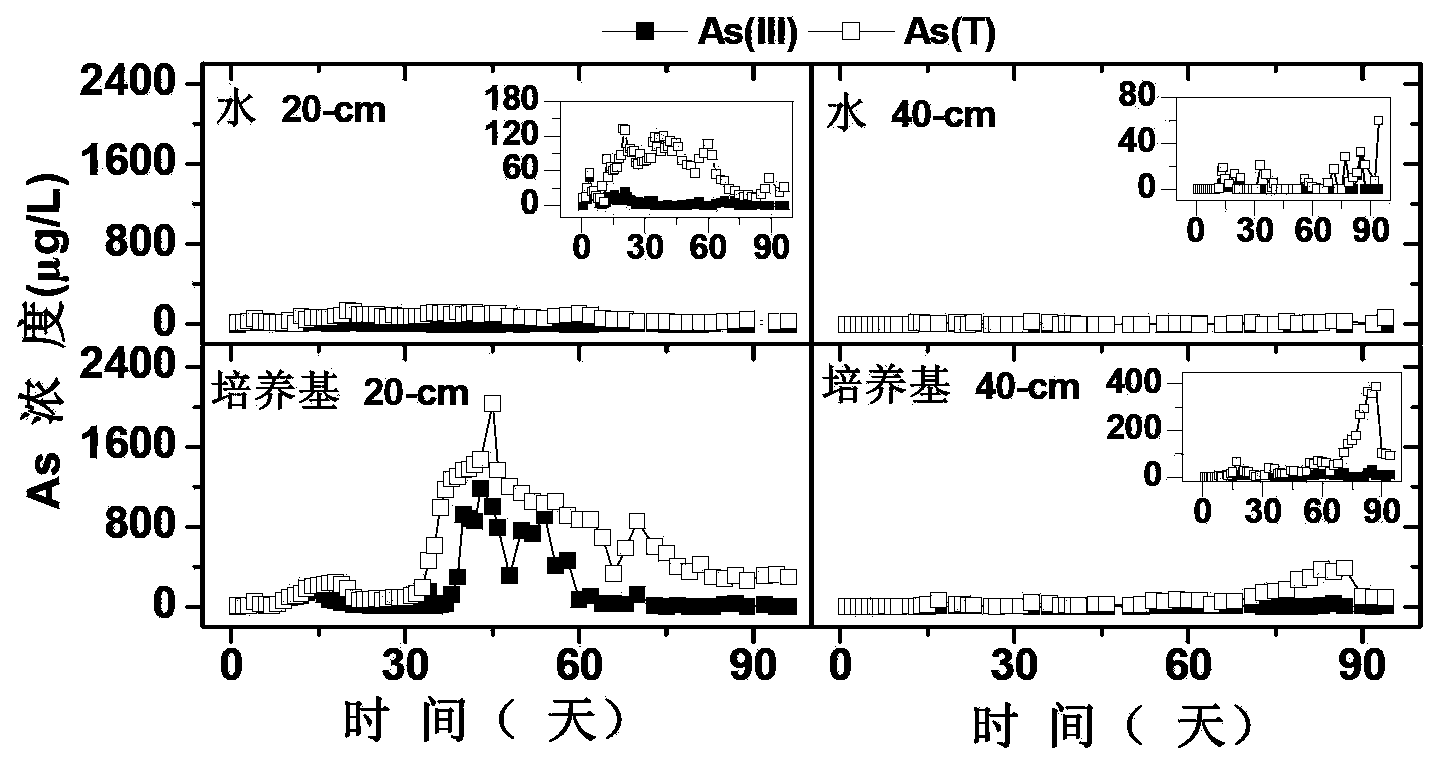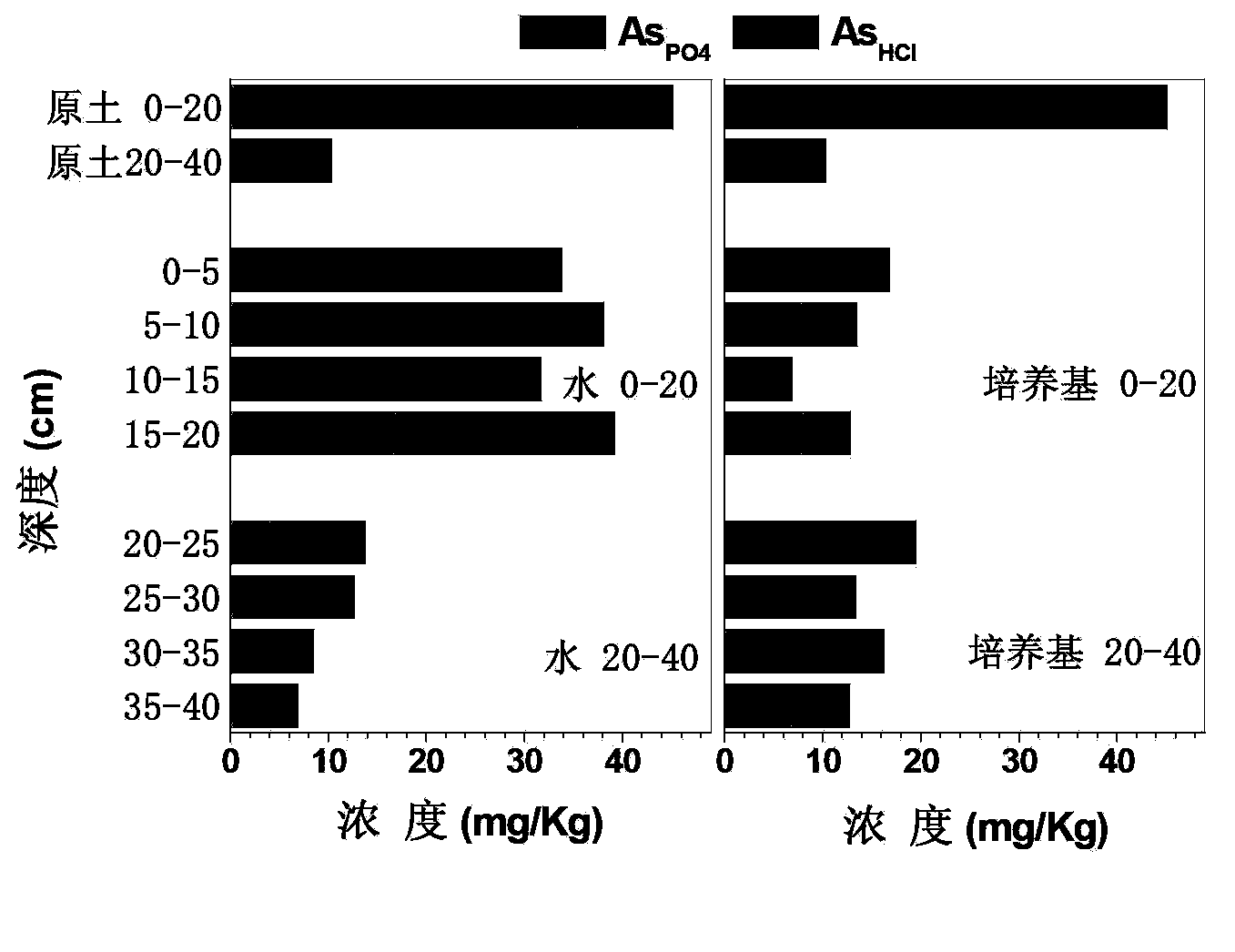In-situ remediation method of arsenic soil pollution
A technology for soil pollution and in-situ remediation, applied in the field of in-situ remediation of arsenic soil pollution, can solve problems such as crop and groundwater pollution and threats, and achieve the effects of not easy secondary pollution, low cost, and simple operation.
- Summary
- Abstract
- Description
- Claims
- Application Information
AI Technical Summary
Problems solved by technology
Method used
Image
Examples
Embodiment 1
[0017] The migration of arsenic in surface soil by medium addition was simulated by column experiments under laboratory conditions:
[0018] Layered collection of 0-20, 20-40cm cultivated soil in Zhangshi, Shenyang, where the arsenic background value is about 10mg·Kg -1 . By artificially adding Na to the surface layer 0-20cm 3 AsO 4 ·7H 2 O to get about 45mg·Kg of arsenic -1 The arsenic-contaminated surface soil (hereinafter referred to as the original soil 0-20).
[0019] The content of each substance in the liquid medium is: 2mL·L -1 Sodium Lactate, KH 2 PO 4 (1.0mM), NH 4 Cl (4.7mM), KCl (6.7mM), CaCl 2 2H 2 O (0.9mM), NaCl (17mM), MgCl 2 ·6H 2 O (3.0mM), Na 2 SO 4 (10mM), add yeast extract powder (0.5g·L -1 ) (purchased from Beijing Aoboxing Biotechnology Co., Ltd.). Each of the substances is prepared with water. At the same time, water (conductivity ≈ 6.91μS·cm -1 ) as a control group for leaching the soil.
[0020] at 0.342cm h -1 Inject the above-men...
Embodiment 2
[0032] The difference from Example 1 is that the content of each substance in the liquid medium is: 10mM glucose, 1mL·L -1 Sodium Lactate, KH 2 PO 4 (2.0mM), NH 4 Cl (5.0mM), KCl (7.0mM), CaCl 2 2H 2 O (1.0mM), NaCl (20mM), MgCl 2 ·6H 2 O (3.0mM) and Na 2 SO 4 (15mM); In addition, add yeast extract powder (0.6g·L -1 ). Each of the substances is prepared with water. And at 0.2cm·h -1 The above-mentioned medium was injected into the surface soil at the flow rate.
Embodiment 3
[0034] The difference from Example 1 is that
[0035] The content of each substance in the liquid medium is: glucose (10mM), KH 2 PO 4 (3.0mM), NH 4 Cl (6.0mM), KCl (10.0mM), CaCl 2 2H 2 O (2.0mM), NaCl (30mM), MgCl 2 ·6H 2 O (5.0mM) and Na 2 SO 4 (10mM), add yeast extract powder (1.0g·L -1 ). Each of the substances is prepared with water. And at 0.5cm·h -1Inject the above medium into the surface soil at a flow rate of
PUM
 Login to View More
Login to View More Abstract
Description
Claims
Application Information
 Login to View More
Login to View More - R&D
- Intellectual Property
- Life Sciences
- Materials
- Tech Scout
- Unparalleled Data Quality
- Higher Quality Content
- 60% Fewer Hallucinations
Browse by: Latest US Patents, China's latest patents, Technical Efficacy Thesaurus, Application Domain, Technology Topic, Popular Technical Reports.
© 2025 PatSnap. All rights reserved.Legal|Privacy policy|Modern Slavery Act Transparency Statement|Sitemap|About US| Contact US: help@patsnap.com


